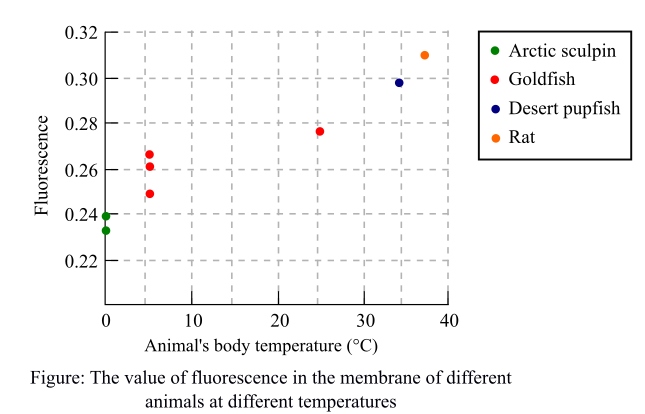
Concept explainers
To analyze:
The inference that can be deciphered from the graph showing the relative fluidity of cell membranes in different species and whether the trend shown is apparent.
Given:
Researchers conducted an experiment to comparatively study the fluidity and composition of cell membranes. They maintained arctic sculpin at 0°C, a group of goldfish at 5°C, other group of goldfish at 25°C. They also maintained the desert pupfish at 34°C, and rats at normal temperature of 21°C. After keeping them for several days, the neuronal cells of all the animals were taken and membranes were isolated.
A fluorescent molecule was added to each of the extracted membranes and kept for some time at 20°C. Researchers then measured fluorescence and a graph was plotted by them. The graph depicted fluorescence against the body temperature of each of the animals.
The following graph shows the fluorescence of each animal depicted as colorful points at different temperatures. The more the value of fluorescence, the less will be the movement of molecules depicting a less fluid membrane.

The following table was drawn by the researchers showing the ratio of saturated-to-unsaturated fatty acids in the phospholipid phosphatidyl choline for different animals taken into consideration.

Introduction:
The membrane is fluid in nature and is responsible for the transport of various molecules in and outside the cell. The fluidity of the membrane depends on the temperature and unsaturation. The low temperature leads to increase in fluidity to cope up the temperature. The saturated fatty acids are those fatty acids which do not have any double bond and have no scope of addition of any molecule. They can only substitute the molecules. The unsaturated fatty acids are those which have one or more double or triple bonds that increase the fluidity of the membrane. The species that survive in lower temperature have more amounts of unsaturated fatty acids so that they can avoid being frozen and remain fluid for transportation of the molecules.
Explanation of Solution
The data in the graph shows the value of fluorescence in different species at different temperature. It was observed that when the temperature of the animal’s body is low as in the case of arctic sculpin, the value of fluorescence is also low. There is an inverse relation between the movement of molecules and value of fluorescence. The low fluorescence depicts the high movement of molecules in the artic sculpin showing that the membrane has greater fluidity. The greater fluidity of the membrane helps these organisms to withstand such low temperature. In contrast, the fluidity of membranes of rats is low as the fluorescence value shown in the graph is high. This indicates that fluidity of membrane is not as high as in the species of low temperature.
The data of membrane fluidity depends on the temperature of the animal and is apparent as the fluidity of the membrane will change according to the change in the temperature.
Thus, it was concluded that the post translational modifications are important for the proper protein functioning and deoxyribonucleic acid (DNA) of the protein decides whether the modification should occur or not. The trend shown in the graph is apparent.
Want to see more full solutions like this?
Chapter 6 Solutions
LIFE:SCIENCE OF BIOL.(LL) >CUSTOM<
- which of the following do molecules use as transportation when they are too large to move through a cell membrane?arrow_forwardUnder what environmental conditions does water move into a cell byosmosis?arrow_forwardIf a percent difference is a negative number, what does this tell us about the change in weight of the artificial cell? If the percent difference is a negative number, what does this tell us about the movement of water across the membrane?arrow_forward
- Controlled exchange of materials occurs between compartments and across cellular membranes. Explain?arrow_forwardWhy is the plasma membrane descibed as a semipermeable membrane? why are proteins required to augment the functions of hte phospholipid bilayer that forms the backbone of cell membranes? distinguish between the different types of molecular transport, why are they necessary, how do they enhance cellular functions, why are some cellualar processes free while others require the input of energy?arrow_forwardWhat type of solution tonicity is cell For A,B, and C ? How do you know?arrow_forward
- a solution is hypotonic relative to a cell, how will water move?arrow_forwardWhy is it advantageous for the cell membrane to be fluid in nature?arrow_forwardDistinguish between the following pairs of terms: a. diffusion; osmosis b. passive transport; active transport c. endocytosis; exocytosisarrow_forward
- What is the correct order of permeability for the following four substances across a pure phosopholipid bilayer? O2 > Na+ > ATP > ethanol Na+ > ATP > O2 > ethanol O2 > ethanol > Na+ > ATP Na+ > ethanol > O2 > ATParrow_forwardIn terms of rate of transport of a molecule across a membrane , what is the difference between passive and active transport?arrow_forwardIn the experimental conditions described below, how many molecules of dextrose do you have to add to the extracellular fluid in order to make it iso-osmotic relative to the intracellular fluid? Intracellular fluid: Number of water molecules = 60 Number of Dextrose molecules = 5 Number of Sucrose molecules = 3 Extracellular fluid: Number of water molecules = 160 Number of dextrose molecule = ???? Number of Sucrose molecules = 0 Enter the number of molecules of dextrose in your answer (format: for 7 enter 7 or 7.00, for 7.5 enter 7.5 or 7.50, for 7.3333 enter 7.33 etc...).arrow_forward
 Biology Today and Tomorrow without Physiology (Mi...BiologyISBN:9781305117396Author:Cecie Starr, Christine Evers, Lisa StarrPublisher:Cengage Learning
Biology Today and Tomorrow without Physiology (Mi...BiologyISBN:9781305117396Author:Cecie Starr, Christine Evers, Lisa StarrPublisher:Cengage Learning Human Biology (MindTap Course List)BiologyISBN:9781305112100Author:Cecie Starr, Beverly McMillanPublisher:Cengage Learning
Human Biology (MindTap Course List)BiologyISBN:9781305112100Author:Cecie Starr, Beverly McMillanPublisher:Cengage Learning Concepts of BiologyBiologyISBN:9781938168116Author:Samantha Fowler, Rebecca Roush, James WisePublisher:OpenStax College
Concepts of BiologyBiologyISBN:9781938168116Author:Samantha Fowler, Rebecca Roush, James WisePublisher:OpenStax College


